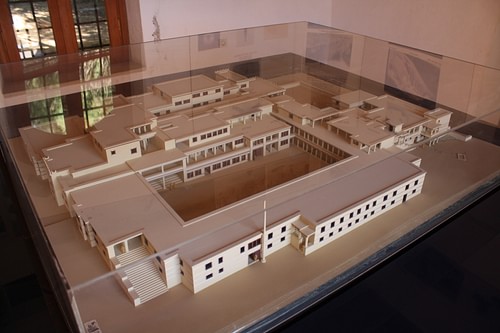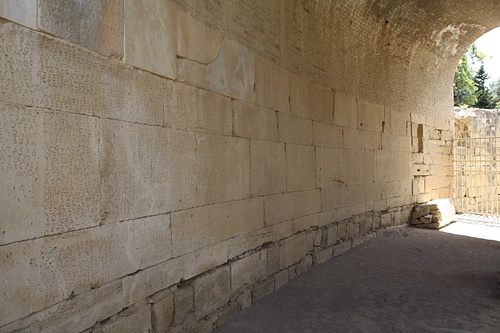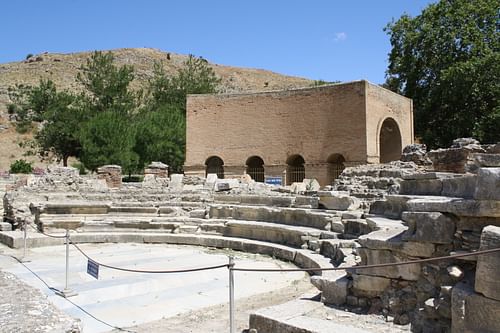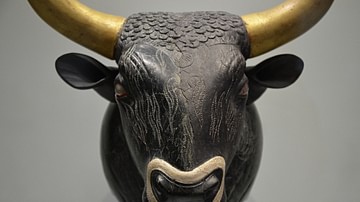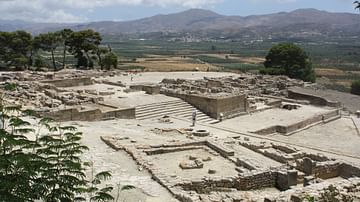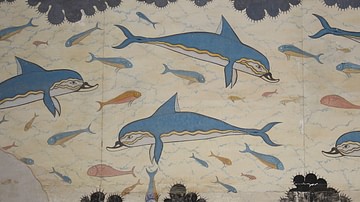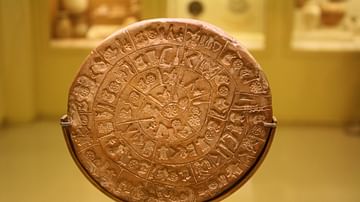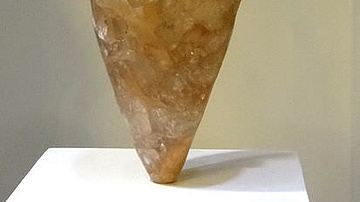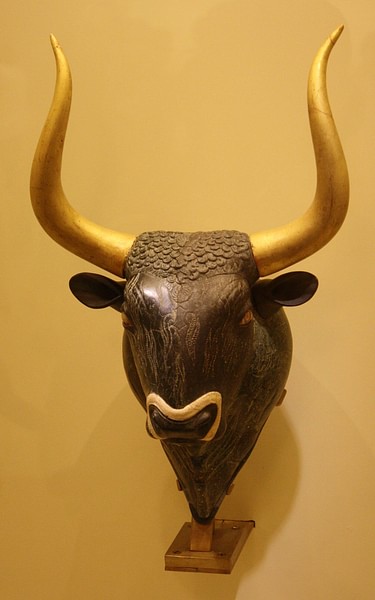
Crete is an island in the eastern Mediterranean which during the Bronze Age produced the influential Minoan civilization with its distinctive architecture and art. An important member of the Greek world in the Archaic period, Crete dipped a little in significance during the Classical period but was again a major cultural centre in Roman times when it was a province within the Roman empire and centre of early Christianity. The island today has many archaeological sites of note which include Knossos, Phaistos, and Gortyn, all with significant architectural remains as compelling evidence of Crete's long and varied history.
Minoan Crete
The earliest evidence of habitation on the island goes back to at least 7,000 BCE when settlers from Anatolia arrived but its first recognisable culture was the Minoans who would provide some of antiquity's most recognisable legends, architecture and artworks, as well as going on to influence many subsequent Mediterranean civilizations. The Minoans rose to prominence from around 2000 BCE, and they would be one of the most successful Mediterranean trading cultures of the Bronze Age. Agriculture and trade allowed the formation of large centralised centres at Knossos, Phaistos, Malia, Zakros, and other sites where grand palatial buildings were constructed and local trade was centralised. These structures were two or three stories high, spread over several thousand square metres, and decorated with fine frescoes. It seems likely that some sort of central administration organised the gathering and storage of materials such as wine, oil, grain, precious metals, and ceramics. The Linear A script, as yet undeciphered, is another indicator of a sophisticated political and trading culture. A relatively peaceful relationship between centres is suggested by the lack of fortification walls, although finds of arrow heads, armour and helmets point to some preoccupation with martial affairs.
The Minoan palaces show evidence of destruction by earthquake c. 1700 BCE, after which they were rebuilt. The palaces were well-appointed, monumental structures with large courts, colonnades, staircases, religious crypts, light-wells, drainage systems, extensive storage magazines for large ceramic pithoi containers, and even 'theatre' areas for public spectacles. The complexity of these palaces, the sport of bull-leaping, the worship of bulls as indicated by the presence throughout of sacred bulls' horns and depictions of double axes (or labrys) all probably gave rise to the legend from Greek mythology of King Minos, ruler of Knossos, and the Athenian hero Theseus who killed the minotaur which dwelt in the labyrinth of the same city. Other features of the Minoan religion besides bulls include the prominence of Nature and fertility goddesses, best seen in voluptuous faience figurines holding snakes.
The Athenian Theseus myth and others, such as Rhea hiding a young Zeus in a cave on Crete, point, as do archaeological finds across the Aegean, to Crete's influence on the wider world. The island's prosperity based on sea trade is attested not only by its monumental architecture but also a flourishing of the arts as best seen in Minoan frescoes, ceramics, jewellery, and figurines. Trade relations are known with Thera, Rhodes, Egypt, the Near East, Cyprus, and the Cyclades, amongst others.
A second wave of earthquakes and destructive fires occurred between 1500 BCE and 1450 BCE which seems to have definitively ended the Minoan presence on Crete. The island may also have suffered a tsunami following the eruption of Thera, although the date of this event is uncertain. The collapse of the Minoan centres, perhaps not coincidentally, was contemporary with the rise of the Mycenaean civilization on mainland Greece. There is evidence that the Mycenaeans ruled at Minoan sites between 1450 and 1380 BCE. Knossos was again destroyed c. 1380 BCE and never rebuilt. By 1200 BCE many of the Minoan settlements had been abandoned.
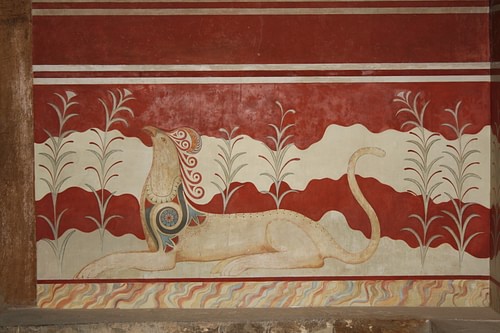
Archaic & Classical Crete
There are no surviving written records of activities on the island between 1200 and 800 BCE but it is known that Dorian-speaking immigrants settled on Crete in that period. Kommos became an important port with evidence of contact with the Greek mainland, Phoenicia, and the Near East, an influence also seen in language and art. New settlements prospered so that by 650 BCE the island boasted, according to Greek tradition, 100 poleis or city-states, many with temples, markets and urban planning. The number was more likely nearer 60 but, nevertheless, Crete was firmly established as an important region of the Greek world, albeit one more disconnected than most others.
Legal texts, the most famous and longest being the law code of Gortyn (c. 450 BCE), show that Cretan cities were composed of various classes of peoples including slaves and foreigners, and had a concern for justice, especially in the fields of family and property law. As with the classic polis model of the Greek mainland, a landed citizenry made up an armed force of hoplites when required and the population as a whole was ruled by an aristocracy which presided over a popular assembly of government. Traditional tribal leaders and noble families would have monopolised public positions, including those related to religious activities which followed the polytheistic pantheon and practices of the Greek mainland.
The very fact that Crete is an island limited its role in Greek regional affairs during the Classical period (600-450 BCE), but Cretan towns did provide warriors – Cretan mercenary slingers and archers being especially highly esteemed – for such conflicts as the Peloponnesian Wars and the campaigns of Alexander the Great and his successors. From the 3rd to 1st century BCE, the formation of a Cretan Federation seems to have done little in arresting the island's general decline into relative obscurity. Many people emigrated to the Greek mainland while Crete now earned a reputation for piracy, a practice which eventually brought about two wars with that other Mediterranean island built on trade: Rhodes (206-204 BCE and 155-153 BCE).
A civil war erupted between the island's three main cities - Gortyn, Knossos, and Lyttos - between c. 222 and 219 BCE. Philip V of Macedon was courted as an ally, but taking advantage of the political weaknesses of the Cretan cities, it was Ptolemy VI who established a garrison in eastern Crete. However, this did not stop the continued civil war between rival cities which rumbled on throughout the 2nd century BCE. A peace was finally established in 110 BCE when the Mediterranean's new superpower Rome stepped into local affairs.
Roman Crete
In the Roman period Cretan piracy was still rife, and it would take two wars in 71 and 69-67 BCE before the ever-determined Romans could finally stamp it out. Crete, thereafter, became something of a pawn in wider Roman regional politics as the Republic went through its death throes. In 36 BCE, for example, Mark Antony gave the island to Cleopatra as a gift. With the succession of Augustus, though, Crete was officially incorporated into the Roman empire. The emperor created a colony at Knossos, and the city, along with the island in general, benefitted from an influx of immigrants which brought a prosperity Crete had not seen for centuries. Prominent settlers included veterans from the legions, traders, and Jews in what became a thriving Roman province with its governor residing at Gortyn. At least 15 cities prospered in this period, oil and wine production increased massively, amphitheatres, temples, Roman baths and aqueducts were built, and the island minted its own coinage. The famed Cretan archers became an important fixture in the Roman army across the empire, but no Roman troops were stationed on Crete itself.
An early Christian community was established at Gortyn c. 60 CE whose first bishop was Titus, a disciple of Saint Paul. Gortyn, in particular, thrived with a population reaching 300,000 and its status confirmed as a major Roman town when the future emperor Trajan was appointed quaestor there in 81 CE. The 3rd century CE saw several infamous persecutions of Christians including ten martyrs during a wild animal hunt in Gortyn's amphitheatre in 249 CE. When the Roman Empire split into two, Crete was made part of the Eastern empire although the Christian church was under the jurisdiction of the Pope at Thessaloniki. The island continued to prosper throughout this period until the Byzantine era when it faced repeated Arab raids and, ultimately, full conquest c. 827 CE.
